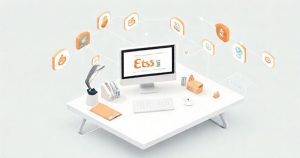Discover the power of Etsy integrations to streamline your creative business and unlock new growth potential. This guide explores how connecting third party applications to your Etsy shop can automate tedious tasks, from marketing and shipping to accounting. By leveraging the right tools, you can save valuable time, reduce manual errors, and focus on what you do best: creating unique products for your customers. Learn how to build a more efficient and profitable Etsy business through smart automation.
Why You Need Etsy Integrations for Your Business
Running a successful Etsy shop involves much more than just creating products. It requires managing listings, marketing, shipping, customer service, and bookkeeping. As your business grows, these manual tasks can become overwhelming, consuming time that could be better spent on product development or strategy. This is where Etsy integrations become essential. They act as a bridge between your shop and other powerful software tools, creating a seamless and automated workflow that propels your business forward.
The primary benefit of using Etsy integrations is efficiency. Automating repetitive processes like creating shipping labels or posting on social media frees up hours each week. This automation also significantly reduces the risk of human error, ensuring order details are correct and financial records are accurate. For sellers looking to scale, integrations are not a luxury but a necessity. They provide the infrastructure needed to handle a higher volume of orders without compromising on quality or customer experience.
Key Categories of Etsy Integrations
To effectively optimize your workflow, it is important to understand the different types of tools available. Most Etsy integrations fall into several key categories, each designed to solve a specific challenge for sellers. By identifying your shop’s biggest pain points, you can choose the right applications to build a more robust and automated system that supports your long term goals and enhances your productivity.
Print on Demand (POD) Integrations
For artists, designers, and creators who sell custom apparel, home decor, or accessories, Print on Demand (POD) services are a game changer. Integrations with platforms like Printful or Printify allow you to list products in your Etsy shop without holding any physical inventory. When a customer places an order, the integration automatically sends the details to the POD provider, who then prints, packages, and ships the product directly to your customer. This model eliminates upfront costs and fulfillment headaches, making it a highly profitable option.
Imagine selling custom t shirts, mugs, and art prints. With a POD integration, your role is focused entirely on design and marketing. You create compelling mockups for your Etsy listings and promote them. Once a sale is made, the entire backend process is handled automatically. This allows you to offer a wide variety of products with different designs and variations, scaling your catalog effortlessly while maintaining high quality standards and excellent customer service through your production partner.
Marketing and Social Media Automation
Building a brand and driving traffic to your Etsy shop requires a consistent marketing effort. Etsy marketing integrations help automate this crucial task. Email marketing tools can connect to your shop to capture customer emails, allowing you to send newsletters, announce new products, or offer special promotions. This helps you build a loyal customer base that exists outside of the Etsy platform, giving you more control over your audience and communication channels.
Similarly, social media management tools can integrate with your shop to streamline your content strategy. You can schedule posts for platforms like Instagram, Pinterest, and Facebook weeks in advance, ensuring a steady stream of content without daily manual effort. Some tools can even automatically create posts from your new Etsy listings, saving you even more time. This consistent online presence is vital for attracting new buyers and reinforcing your brand identity in a competitive marketplace.
Accounting and Financial Management
One of the most challenging aspects of running an Etsy business is managing finances. Manually tracking sales, fees, and expenses is not only time consuming but also prone to errors. Accounting integrations are designed to solve this problem by syncing your Etsy sales data directly with financial software like QuickBooks or Xero. This automation provides a clear, real time picture of your shop’s financial health, making tax preparation and profit analysis significantly easier and more accurate.
These tools automatically categorize your Etsy fees, material costs, and revenue, generating professional reports that show your profitability per product or over specific periods. Instead of spending hours buried in spreadsheets at the end of each month, you can get an instant overview of your cash flow. This financial clarity is crucial for making informed business decisions, such as setting product prices, managing your budget for supplies, and planning for future growth.
Choosing the Right Integration for Your Etsy Shop
With so many options available, selecting the right Etsy integrations for your shop can seem daunting. The key is to start by identifying your biggest operational bottleneck. Are you spending too much time on shipping? Is marketing an afterthought? Do you struggle with bookkeeping? Pinpointing your main challenge will help you prioritize which type of tool will offer the most immediate impact. Once you have identified a need, you can explore specific applications that specialize in that area.
When evaluating a potential integration, consider the following factors:
- Functionality: Does the tool do exactly what you need it to do? Avoid overly complex software with features you will never use.
- Reliability and Reviews: Look for established tools with positive reviews from other Etsy sellers. Reliability is critical, as a buggy integration can create more problems than it solves.
- Cost vs. Value: Many integrations come with a subscription fee. Calculate the value of the time you will save and determine if the cost is a worthwhile investment for your business.
- User Experience: The tool should be intuitive and easy to connect to your Etsy shop. A complicated setup process or a confusing interface can defeat the purpose of saving time.
The Impact of Automation on Profitability
The true power of Etsy integrations lies in their direct impact on your bottom line. While they often require a monthly investment, their return is measured in both saved time and increased revenue. Consider a seller who spends eight hours per week manually creating shipping labels and sending tracking updates. By integrating a shipping management tool, this process could be reduced to just one hour per week. Those seven saved hours can now be reinvested into activities that generate income, such as product photography, keyword research, or developing a new product line.
This strategic reallocation of time is what separates hobbyist shops from scalable businesses. Automation handles the operational logistics, allowing you to function as a creative director and strategist for your brand. This leads to better products, more effective marketing, and a superior customer experience, all of which contribute to higher sales and greater profitability. An integrated shop is not just more efficient; it is positioned for sustainable, long term growth in the competitive handmade marketplace.
Unlocking Your Etsy Potential Through Smart Automation
Ultimately, Etsy integrations are strategic assets that empower you to build a more professional and resilient business. They are not about replacing the human touch that makes Etsy special but about removing the operational friction that holds sellers back. By carefully selecting and implementing tools that automate your workflow, you create a system that works for you, giving you the freedom and clarity to focus on growth. The journey to a seven figure shop begins with smart systems, and automation is the cornerstone of that foundation.






